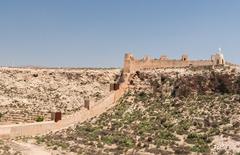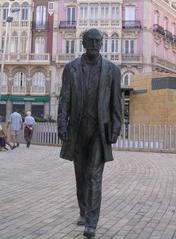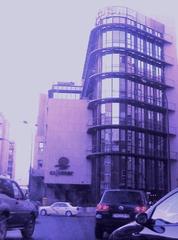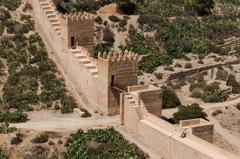Alcazaba y Murallas del Cerro de San Cristóbal: Visiting Hours, Tickets, and Comprehensive Guide to Almería’s Historical Sites
Date: 15/06/2025
Introduction
The Alcazaba y Murallas del Cerro de San Cristóbal in Almería, Spain, stand as enduring monuments of over a thousand years of cultural, military, and architectural significance. Rising above the city, these fortifications not only reflect the evolving history of Almería—from its Islamic origins to its Christian transformation—but also remain a living testament to Andalusia’s multifaceted heritage. This guide will provide a detailed exploration of the Alcazaba and its adjoining walls, including historical context, architectural highlights, practical visitor information (hours, ticketing, and accessibility), travel tips, and cultural insights. Whether you are a history enthusiast, architecture aficionado, or a curious traveler, the Alcazaba promises an immersive journey through Spain’s rich past. For the latest updates and interactive experiences, consider using official mobile apps like Audiala (Audiala app).
Contents
- Introduction
- Historical Overview
- Origins and Early History
- Construction and Expansion
- Architectural Evolution
- The Three Enclosures
- Murallas del Cerro de San Cristóbal
- Medieval Significance
- Economic and Cultural Flourishing
- Transition to Christian Rule
- Modern Era and Conservation
- Visitor Information
- Visiting Hours
- Tickets and Prices
- Accessibility
- Guided Tours and Special Events
- Nearby Attractions and Photographic Spots
- Architectural Features and Layout
- Cultural and Social Context
- Frequently Asked Questions (FAQ)
- Visuals and Media
- Summary and Call to Action
- References
Historical Overview
Origins and Early History
Founded in the 10th century under Abd al-Rahman III, the first caliph of al-Ándalus, the Alcazaba was initially constructed as a fortified stronghold to protect the rapidly growing port city of Al-Mariyya Bayyana—modern Almería. It quickly became a military and naval hub, renowned for its shipbuilding and bustling trade, attracting merchants from across the Mediterranean (eldebate.com).
Construction and Expansion
The fortress was expanded over centuries, reflecting the changing needs of its rulers. By the taifa period, the Alcazaba had become one of the largest Muslim fortifications in Spain, second only to the Alhambra. Its strategic hilltop location provided a commanding vantage over the city and coast, making it a key defensive and administrative center (andaluciarustica.com).
Architectural Evolution
The Three Enclosures
The Alcazaba is organized into three distinct enclosures, each marking a different period and function:
- First Enclosure: Originally featuring residences and a cemetery, this area was restored in the 20th century and now boasts lush gardens inspired by Andalusian designs.
- Second Enclosure: The administrative and palatial core, containing the governor’s residence, baths, cisterns, and a mosque, later converted into the Ermita Mudéjar de San Juan.
- Third Enclosure: Built after the 1489 Christian conquest, this section features robust stone towers and artillery defenses, including the Torre del Homenaje and semicircular towers typical of Christian military architecture (enamoradosdealmeria.es).
Murallas del Cerro de San Cristóbal
Extending north from the Alcazaba, the Murallas del Cerro de San Cristóbal comprise defensive walls and towers built by Jayrán, the first taifa king of Almería, in the 11th century (turismodealmeria.org). These walls, featuring both Islamic square and Christian semicircular towers, protected the musalla quarter and connected the fortress to the Cerro de San Cristóbal, which is crowned by the imposing statue of Saint Christopher.
Medieval Significance
Economic and Cultural Flourishing
From 955 to 1146, Almería thrived as a cosmopolitan port, with its market attracting traders from Egypt, Syria, France, and Italy. The Alcazaba served as both a military bastion and a symbol of the city’s maritime and commercial prominence (eldebate.com).
Transition to Christian Rule
In 1489, the Catholic Monarchs captured Almería, integrating the Alcazaba into the Kingdom of Granada. They transformed the fortress by adding new defensive structures and Christian architectural elements, most notably the third enclosure and enhanced artillery defenses (enamoradosdealmeria.es).
Modern Era and Conservation
After military use declined in the 19th century, the Alcazaba fell into disrepair. Restoration efforts in the 1940s began the process of stabilization and public opening. Since 1989, the Junta de Andalucía has managed the site, designating it a Bien de Interés Cultural in 2004 and proposing it as a UNESCO World Heritage candidate in 2022 (es.wikipedia.org).
Visitor Information
Visiting Hours
- Standard Hours: Tuesday to Saturday, 9:00 AM – 9:00 PM (March–October); Sundays, 9:00 AM – 3:00 PM. Winter hours (October–March): 9:00 AM – 6:00 PM.
- Closed: Mondays and certain public holidays.
- Recommendation: Always confirm current hours via the official website or local tourism office as schedules may change seasonally.
Tickets and Prices
- Admission: Free for EU citizens; non-EU visitors pay a nominal fee (approx. €3-5).
- Discounts: Available for students, seniors, and groups.
- Purchase: Tickets can be bought on-site or online; online purchasing is recommended during peak periods.
Accessibility
- The terrain includes uneven surfaces, stairs, and steep sections, especially in upper enclosures and towers.
- Improvements have been made, but accessibility is limited; visitors with reduced mobility are advised to contact the site in advance or visit primarily the lower enclosures.
Guided Tours and Special Events
- Guided Tours: Free tours available every Saturday at 9:00 AM; additional tours can be booked through local agencies and the Museo de Almería.
- Special Events: The Alcazaba hosts cultural festivals, performances, and night tours, especially during summer months.
Facilities
- Food and Drink: No café on-site, but vending machines are available; nearby restaurants in the historic center.
- Shops: Souvenir shop at the exit.
- Rest Areas: Limited shaded seating; bring water and sun protection.
Getting There
- On Foot: Short uphill walk from the old town.
- Public Transport: Well-connected by bus; train and bus stations are nearby.
- Parking: Limited; public transport or walking recommended.
Architectural Features and Layout
- Gardens and Water Features: The first enclosure’s gardens evoke the refined aesthetics of Al-Andalus, with fountains and shaded pathways (andaluciarustica.com).
- Towers: Signature structures like the Torre del Homenaje and Torre de la Pólvora offer panoramic city views (barcelo.com).
- Walls and Defensive Elements: Over 1.4 kilometers of walls, including the Muralla de Jayrán, showcase the fortress’s military prowess (audioguia.org).
- Palatial and Civic Spaces: Archaeological remains include cisterns, baths, a mosque/ermita, and residential quarters (prepararmaletas.com).
Cultural and Social Context
- Symbol of Almería: The Alcazaba and Cerro de San Cristóbal are central to the city’s identity, blending Islamic, Christian, and local traditions (enamoradosdealmeria.es).
- Community Engagement: The site hosts festivals and events, supports local heritage, and remains a popular gathering place.
- Museum Connections: Artifacts are displayed at the Museo de Almería and Museo de la Alhambra, providing further historical depth (whichmuseum.com).
Frequently Asked Questions (FAQ)
Q: What are the Alcazaba visiting hours?
A: Typical hours are 9:00 AM to 9:00 PM (March–October), and 9:00 AM to 6:00 PM (October–March); closed Mondays.
Q: How much does admission cost?
A: Free for EU citizens; €3–5 for non-EU visitors, with discounts available.
Q: Are guided tours available?
A: Yes, free guided tours are offered on Saturdays. Additional tours can be arranged via local agencies and the Museo de Almería.
Q: Is the Alcazaba accessible for visitors with disabilities?
A: Some areas are accessible, but the terrain can be challenging. Advance inquiry is recommended.
Q: Are there facilities for children?
A: While there are no dedicated children’s routes, the gardens and towers are engaging; supervision is advised due to stairs and uneven ground.
Q: Is the Cerro de San Cristóbal open to visitors?
A: The walls themselves are not open, but the hill and viewpoints are accessible and popular for photography and sunset viewing.
Visuals and Media
Visitors are encouraged to explore interactive maps, virtual tours, and photo galleries available on official and tourism websites. Panoramic photos of the Alcazaba, its gardens, and city views—especially at sunset—are highly recommended for sharing and trip planning.
Summary and Call to Action
The Alcazaba y Murallas del Cerro de San Cristóbal encapsulate a millennium of Almería’s history, blending Islamic and Christian heritage, formidable architecture, and vibrant community life. With flexible visiting hours, affordable or free entry, and a wealth of cultural and photographic opportunities, these sites are essential for any visitor to Andalusia. Enhance your experience by planning ahead, joining guided tours, and exploring the surrounding historic center.
Download the Audiala app for real-time updates, event notifications, interactive guides, and exclusive insights into Almería’s historical treasures. Follow us on social media and explore related articles to uncover more about Andalusia’s rich heritage.
References
- Breve historia de la Alcazaba de Almería: Origen como atalaya y ciudad milenaria, eldebate.com (eldebate.com)
- Alcazaba de Almería y Murallas del Cerro de San Cristóbal, andaluciarustica.com (andaluciarustica.com)
- Capital: Cerro de San Cristóbal, enamoradosdealmeria.es (enamoradosdealmeria.es)
- Conjunto Monumental de la Alcazaba, saposyprincesas.elmundo.es (saposyprincesas.elmundo.es)
- What to Do in the City of Almería, mappingspain.com (mappingspain.com)
- Alcazaba Almería - Things to Do, barcelo.com (barcelo.com)
- El Cerro de San Cristóbal, almeriahoy.com (almeriahoy.com)
- Alcazaba Almería Guide and Tips, prepararmaletas.com (prepararmaletas.com)
- Alcazaba Almería Info, audioguia.org (audioguia.org)
- Alcazaba y Murallas del Cerro de San Cristóbal, es.wikipedia.org (es.wikipedia.org)
- Alcazaba y Murallas del Cerro de San Cristóbal, urbipedia.org (urbipedia.org)
- Alcazaba of Almería, whichmuseum.com (whichmuseum.com)
- Visit Fortress Alcazaba Almería, andalucialovers.com (andalucialovers.com)
- Alcazaba and Murallas as Bien de Interés Cultural and UNESCO candidacy, enamoradosdealmeria.es (enamoradosdealmeria.es)
- Alcazaba y Murallas del Cerro de San Cristóbal Coin Commemoration, es.wikipedia.org (es.wikipedia.org)
- Alcazaba Almería and Murallas del Cerro de San Cristóbal Guide, turismodealmeria.org (turismodealmeria.org)



